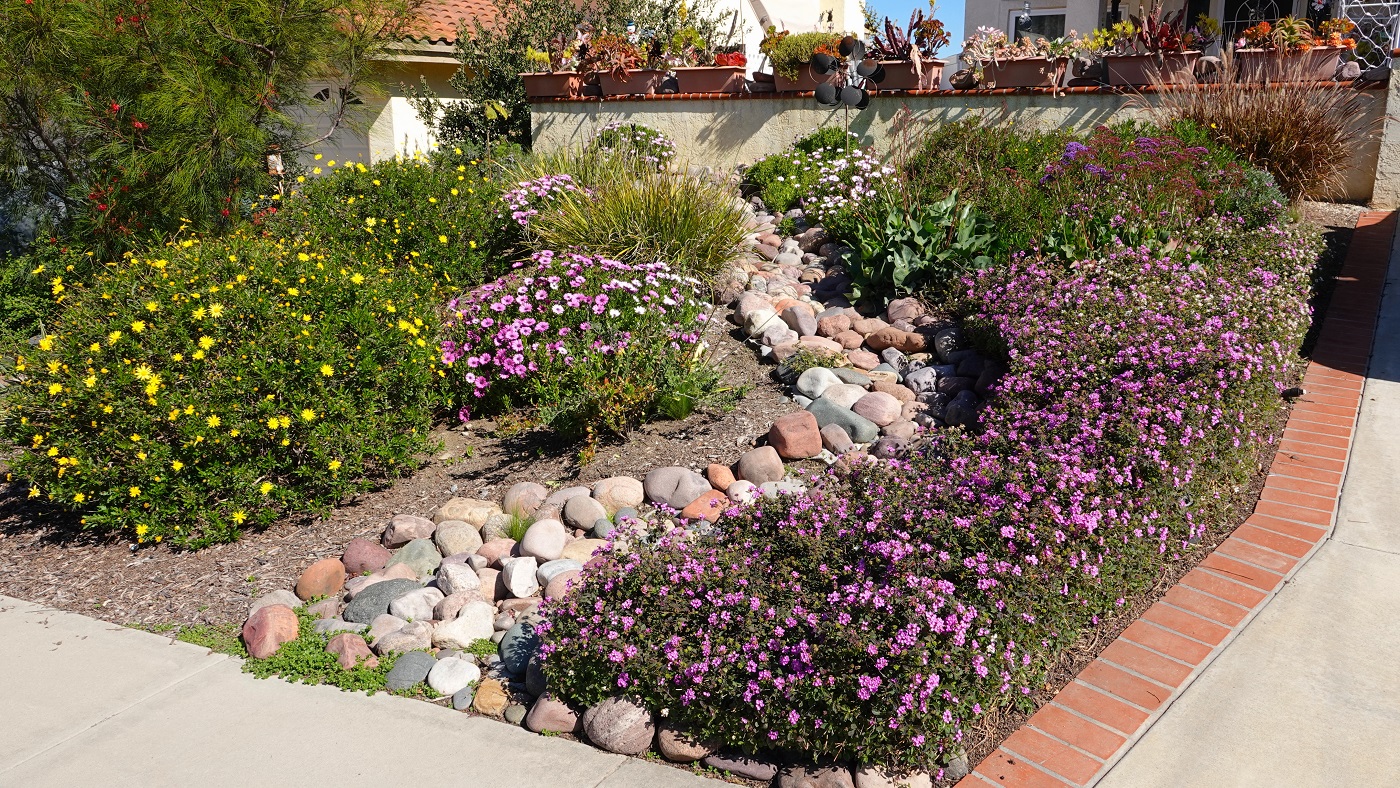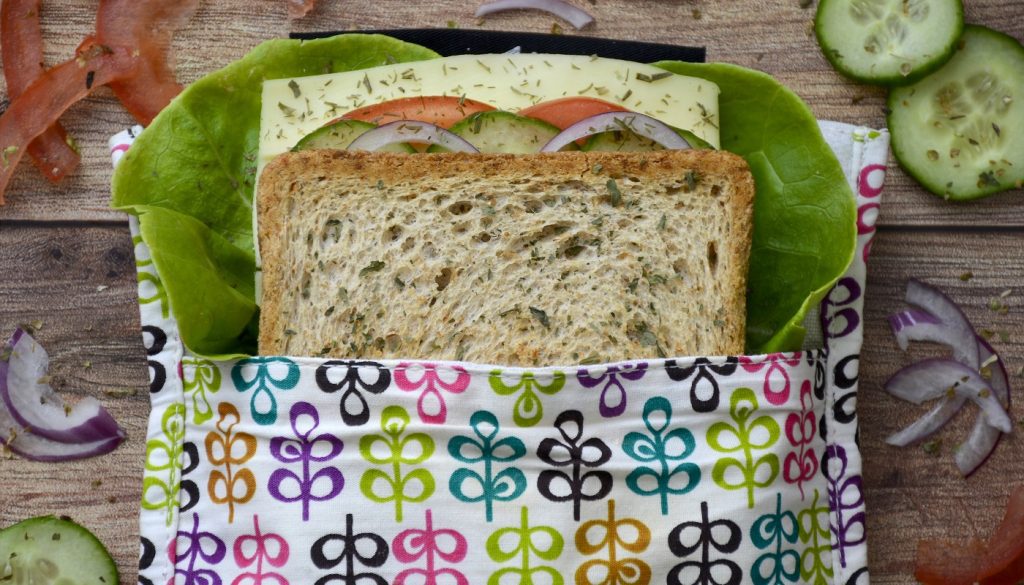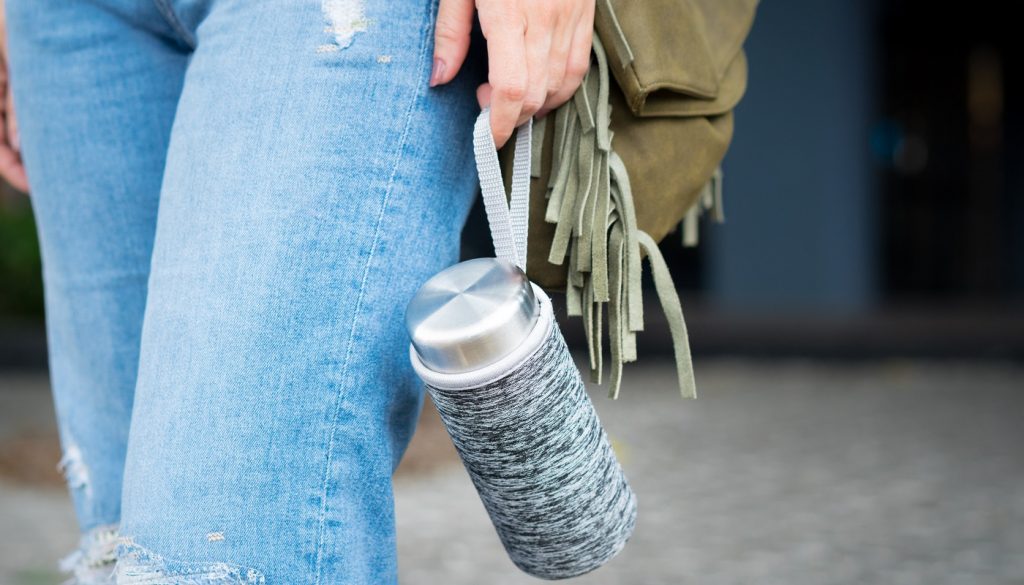It’s summer again, which means it’s time to be outside working on your lawn. Have you ever wanted to give up on caring for your grass altogether? Find out why grass is unsustainable, and why naturescaping is a compelling alternative.
What’s the deal with grass?
Grass lawns are ubiquitous in the United States, especially in the suburbs. Have you ever wondered why it’s the default choice for landscaping?
The first grass lawns in Europe were a status symbol for wealthy landowners, since they were the only ones who could afford the laborious upkeep and to grow something other than food. Lawns were a manicured view of nature, nicely contained in a little box.
Grass lawns began to see widespread adoption in the US after WWII with a housing boom and increased suburbanization. With the invention of the lawnmower and introduction of European plants, lawns were much more manageable for average, middle class people. There was still prestige in owning a lawn, but it fell more to a “keeping up with the Joneses” mentality.
Now, most Americans don’t even question lawns. They’re ingrained enough into our cultural sensibilities that there’s a $115 billion industry to support them. Let’s look into an alternative to grass lawns, and why you should consider ditching the lawnmower for good.
What is naturescaping?
Naturescaping, or natural landscaping, prioritizes native plants in order to support the local ecosystem. Often, this means ditching traditional grass in favor of local alternatives like clover and wildflowers.
Naturescaped yards require fewer chemical fertilizers and pesticides since the plants they grow are evolutionarily meant to be there. They also offer food and shelter to local animals and insects.
Why is naturescaping important?
Naturescaping is a great alternative to having a traditional grass lawn. But what exactly makes it the more eco-conscious choice?
It’s better for the bees
Even though having green grass feels like you have a piece of nature in your lawn, that’s far from the case. A grass lawn is a monoculture: all one plant. Gardeners meticulously remove “weeds” like dandelions and clovers, so there are no flowering plants for pollinators.
Naturescaped lawns include a variety of flowering plants so there’s food for pollinators all summer, which is vital for our dwindling insect and songbird populations.
It uses fewer resources
Grass lawns are costly to maintain. In order to stay green, they need constant watering, fertilizing, and mowing. Landscape irrigation accounts for one third of all US residential water use, or about 9 billion gallons a day. Households in drought areas could use as much as 60% of their water on their lawn.
Part of what makes grass require so many resources is that it’s not meant to grow there. In order to keep it green in the arid western US, it needs exorbitant amounts of water. But native plants evolved to live in hotter, dryer conditions, so they need less water to thrive.
It challenges invasives
Invasive species are plants and animals brought from around the world that thrive a little too well in their new environment. Sometimes they spread accidentally, like when mussels attach onto international ships. Often, though, invasive plants are deliberately introduced for their appearance in landscaping.
Most invasive plants are so successful because they produce large quantities of seed and have aggressive root systems. When they spread into an area, they choke out native plants by stealing resources. They’ve contributed to the decline of 42% of endangered and threatened species.
Naturescaped yards encourage native plants to thrive, which gives fewer opportunities for invasive plants to spread.
How to naturescape your backyard
Plantnative.org has great step-by-step guides on how to develop a naturescape, which you can visit for detailed steps. Or, stay here for the highlights!
1. Scope out your area
Before you can do anything, you need to know what you’re working with. Walk around your yard and make notes of how sunny it is, what type of soil you have, if the ground is flat or sloped, and any immovable structures like driveways.
It’s good to do this during multiple times of the day, and multiple times of year if you can. Ideally, you’re developing a tiny ecosystem that will go through a full life cycle over the year.
In order to choose plants that will thrive, you’ll need to know the conditions they’ll be growing in. So making a rough sketch of which areas are sunny, which areas are prone to standing water, and where your kids will be playing can be helpful.
2. Make a plan
Next, think about the layout of your space. What will you be using it for? Do you have elements you know you want to incorporate, like space for a grill or a swingset? Do you have children and pets who will be playing in the space?
Once you know what all the elements will be, play around with their placement on paper. You can just draw rough shapes while you’re still deciding what you want. Remember to consider how people will move from one place to another, maybe making paths in between your different areas.
3. Choose your native plants
Use this tool from the National Wildlife Federation to determine which plants are native to your zip code. It even tells you which butterflies and moths use the plants as a host. If you’d like, you can also purchase bundles of native plants through their affiliate site, Garden for Wildlife.
It can also be a good idea to visit some natural areas nearby like state parks or wildlife reserves to see how these plants actually grow in the wild. Which flowers like to grow together? Which ground cover likes to be around which trees? Seeing the natural environment can provide a lot of inspiration for naturescaping.
4. Get rid of current plants
First things first, get rid of that grass! You can either dig it up with a rototill or by hand, or smother it by cutting it very short and covering it with leaf mulch. Keep in mind that leaving soil exposed will open the door for opportunistic plants to sprout up, so cover your soil if you’re not ready to plant immediately.
During this step, also be sure to remove any invasive plants that might be growing in your yard. Depending on the species, this could be a very involved task. Invasive plants steal nutrients from native ones, and often can’t support the ecosystem in the same way. Check out which ones are most pervasive in your region here.
5. Rebuild the soil
Unfortunately, you’ll need to do a little more than removing your grass and replacing it with native plants. Most grass lawns grow in the mineral layer of soil, which is dense and can’t support most herbaceous plants. In nature, there’s about 3-4 inches of an organic soil layer on top of the mineral layer, which is made up of decomposed leaves and needles.
You’ll need to rebuild the organic soil layer manually so it can support the native plants you’ll be bringing in. Leaf mulch is perfect for this task. Leaves break down relatively quickly, which will quickly reintroduce nutrients into your soil. Avoid bark mulch and commercial yard compost, as these might have unknown weed seeds in them.
6. Time to plant!
Once you have your plants chosen and your yard prepared, it’s time to get planting! You can choose to use young sprouts or seeds, depending on preference and availability. It’s typically best to plant during the dormant season of a plant, which is late fall through early spring in North America.
For larger shrubs and trees, you might choose bare root plants that are more established. These are best planted in the fall so they have the full winter to establish their roots before the spring and summer. For seeds, be sure to research how they will germinate and grow best (depth of planting, how much water and sunlight, etc).
You’ll want to keep tabs on your plants after putting them in your lawn. Are they making solid progress, or does their health seem to be declining? Are invasive weeds stunting their growth? The first year or two are critical for your plants as they become established.
7. Maintenance
Fortunately, naturescaping requires a lot less work than a traditional lawn once your plants are established. Depending on rainfall in your area, your plants may benefit from some watering. You can also keep the soil rich with nutrients by periodically adding compost (perhaps from your kitchen). And be sure to keep an eye out for invasive plants- it’s far better to catch them early!
5 naturescaping examples to inspire you
Check out these awesome humans on TikTok who are tending to naturescapes of their own!
1. Edie, @edieseesdeadpeople
@edieseesdeadpeople Reply to @saskaskrt thank you so much for being so into my crazy little corner of the world. Registering your yard is easy - go to the NWF website and check to see if your yard meets the requirements 🐝 #lawnsworkforthebourgeoisie #pollinatoryard #nwf ♬ Music For a Sushi Restaurant - Harry Styles
Edie is a Colorado gardener who uses her platform to share her “yarden” and educate people about naturescaping! She’s also registered through the National Wildlife Federation as a certified wildlife habitat.
2. Angie, @mnnature_awesomeness
@mnnature_awesomeness Reply to @beeeeccc I ❤️ wild and woolly yards but here are a few tricks to make native plant gardens look more intentional #nativeplants #gardening ♬ original sound - Angie Hong
Angie is a Minnesota gardener who shares her native plant expertise with her audience. She shares a lot of great resources about how to find appropriate native plants, how to tend a native garden, and how to attract pollinators.
3. Kyle, @nativeplanttok
@nativeplanttok Kill your lawn grass and plant the plants native to your area! #nativehabitatproject #plantnative #conservation #grasslands #DuluthTradingCo ♬ original sound - Kyle Lybarger
Kyle is an Alabama forester and advocate of native plants in gardening. He utilized his first-hand knowledge about the harm of invasive plants to transform his yard into a miniature prairie.
4. @allmyroots
@allmyroots Ditch the lawn & let this gorgeous native ground cover take over instead! #nativeplanttok #frogfruit #Phyla #nativeplants #floridanativeplants #lawnweeds #plantidentification #floridaforaging #foraging #floridawildflowers #wildflowers #hostplant #FORDfortheBuilders #fyp #LIKEABOMBSHELL #fy #perennial #grasstiktok #springforaging #wildmedicinalplants #Phylanodiflora #matchhead ♬ original sound - AllMyRoots
AllMyRoots is a Florida-based creator who focuses on native plants that are also edible for humans. Her content is a great reminder that your yard can be a source of food for both pollinators and you!
5. @midwestmomforqueers
@midwestmomforqueers POLLINATOR YARD! #lawnsaredone #pollinatoryard #wildflower #nativeplants #savethebees ♬ original sound - Midwest Mom for Queers
Midwest Mom for Queers is a creator who is new to native gardening, and documenting her progress on TikTok! Her page could be great inspiration if you’re also just beginning your naturescaping journey.
Final Thoughts
Even though it might seem like a lot of work to set up a naturescape, it will pay off in the long run. Just keep reminding yourself that you’ll never have to mow your lawn again!
Having native plants in your yard is one of the most sustainable things you can do in your garden, other than growing your own food. Even if you can only add a few plants instead of reinventing your entire landscape, it will make a big difference.
If you don’t have a yard because you live in a city or apartment, you might even consider having native plants on your balcony or windowsill. Every plant helps our pollinators!
For more sustainable home and garden tips, check out our article on how to start composting. Thanks for reading, and keep fighting the good fight!






